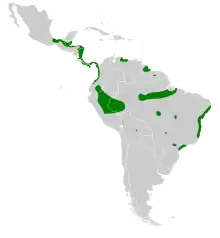Uniform crake
The uniform crake (Amaurolimnas concolor) is a species of bird in the subfamily Rallinae of the rail, crake, and coot family Rallidae.[4][5] It is found in Mexico, most of Central America, and in nine South American countries.[6][7]
| Uniform crake | |
|---|---|
 | |
| Amaurolimnas concolor | |
| Scientific classification | |
| Domain: | Eukaryota |
| Kingdom: | Animalia |
| Phylum: | Chordata |
| Clade: | Dinosauria |
| Class: | Aves |
| Order: | Gruiformes |
| Family: | Rallidae |
| Genus: | Amaurolimnas Sharpe, 1893 |
| Species: | A. concolor |
| Binomial name | |
| Amaurolimnas concolor (Gosse, 1847) | |
 | |
| Synonyms | |
Taxonomy and systematics
The uniform crake was first described in genus Rallus and at various times since then placed in genera Aramides and Laterallus before its present Amaurolimnas.[3][2] It is the only member of that genus and has two extant subspecies, A. c. guatemalensis and A. c. castaneus. The nominate subspecies, the Jamaican wood rail (A. c. concolor), which was endemic to Jamaica, is extinct.[4]
Description
The uniform crake is 20 to 23 cm (7.9 to 9.1 in) long and weighs about 95 to 130 g (3.4 to 4.6 oz). The sexes are alike. They have a medium length yellowish green bill, a red eye, and pinkish red legs and feet. A. c. guatemalensis is the larger of the two living subspecies; it has olivaceous brown upperparts and brown underparts. A. c. castaneus is also olivaceous brown above, but has rufous brown underparts.[3]
Distribution and habitat
The uniform crake has a highly disjunct distribution. Subspecies A. c. guatemalensis is found from Veracruz and Oaxaca in southern Mexico through Central America (except El Salvador) and western Colombia into northwestern Ecuador. A. c. castaneus is found in northern Venezuela, the Guianas, several separate areas of Brazil both inland and coastal, eastern Ecuador and Peru, and locally in Bolivia. It inhabits a variety of wet to almost dry landscapes including wooded swamps, flooded forest, heavily vegetated ravines and streams, and dense vegetation on the edges of secondary forest and cultivated areas. In elevation it ranges from sea level to about 1,000 m (3,300 ft).[3]
Behavior
Movement
The movements of the uniform crake, if any, are not known.[3]
Feeding
The uniform crake mostly forages in cover, where it searches leaf litter and other detritus and digs in mud with its bill. Its diet includes earthworms, insects and spiders, small amphibians and lizards, seeds, and berries.[3]
Breeding
The uniform crake's breeding season is essentially unknown; in Costa Rica it does include July. It is thought to be territorial in the breeding season. One nest in Costa Rica was in a swamp forest near a stream. It was a cup made of leaves in the top of a vine-covered stump and contained four eggs.[3]
Vocalization
The uniform crake's song is a "series of 6–20 upslurred 'tooee' whistles". Pairs maintain contact with "clear, but not loud, whistled 'tooo' notes". The species' alarm call is "a sharp, nasal 'kek'".[3]
Status
The IUCN has assessed the uniform crake as being of Least Concern. It has a very large range and an unknown population size that is believed to be decreasing. No immediate threats have been identified.[1] Its distribution is spotty even within larger areas of its range. "Because of its secretive habits [the] species is undoubtedly overlooked, and is possibly more widely distributed than currently known, but [is] certainly adversely affected by destruction of its forest habitats."[3]
References
- BirdLife International (2021). "Uniform Crake Amaurolimnas concolor". IUCN Red List of Threatened Species. 2021: e.T22692601A163610586. doi:10.2305/IUCN.UK.2021-3.RLTS.T22692601A163610586.en. Retrieved 14 October 2022.
- Remsen, J. V., Jr., J. I. Areta, E. Bonaccorso, S. Claramunt, A. Jaramillo, D. F. Lane, J. F. Pacheco, M. B. Robbins, F. G. Stiles, and K. J. Zimmer. Version 24 July 2022. A classification of the bird species of South America. American Ornithological Society. https://www.museum.lsu.edu/~Remsen/SACCBaseline.htm retrieved July 24, 2022
- Taylor, B. (2020). Uniform Crake (Amaurolimnas concolor), version 1.0. In Birds of the World (J. del Hoyo, A. Elliott, J. Sargatal, D. A. Christie, and E. de Juana, Editors). Cornell Lab of Ornithology, Ithaca, NY, USA. https://doi.org/10.2173/bow.unicra1.01 retrieved October 14, 2022
- Gill, F.; Donsker, D.; Rasmussen, P., eds. (August 2022). "Finfoots, flufftails, rails, trumpeters, cranes, Limpkin". IOC World Bird List. v 12.2. Retrieved August 9, 2022.
- HBW and BirdLife International (2021) Handbook of the Birds of the World and BirdLife International digital checklist of the birds of the world. Version 6. Available at: http://datazone.birdlife.org/userfiles/file/Species/Taxonomy/HBW-BirdLife_Checklist_v6_Dec21.zip retrieved August 7, 2022
- Chesser, R. T., S. M. Billerman, K. J. Burns, C. Cicero, J. L. Dunn, B. E. Hernández-Baños, R. A. Jiménez, A. W. Kratter, N. A. Mason, P. C. Rasmussen, J. V. Remsen, Jr., D. F. Stotz, and K. Winker. 2022. Check-list of North American Birds (online). American Ornithological Society. https://checklist.aou.org/taxa
- Remsen, J. V., Jr., J. I. Areta, E. Bonaccorso, S. Claramunt, A. Jaramillo, D. F. Lane, J. F. Pacheco, M. B. Robbins, F. G. Stiles, and K. J. Zimmer. Version 24 July 2022. Species Lists of Birds for South American Countries and Territories. https://www.museum.lsu.edu/~Remsen/SACCCountryLists.htm retrieved July 24, 2022
